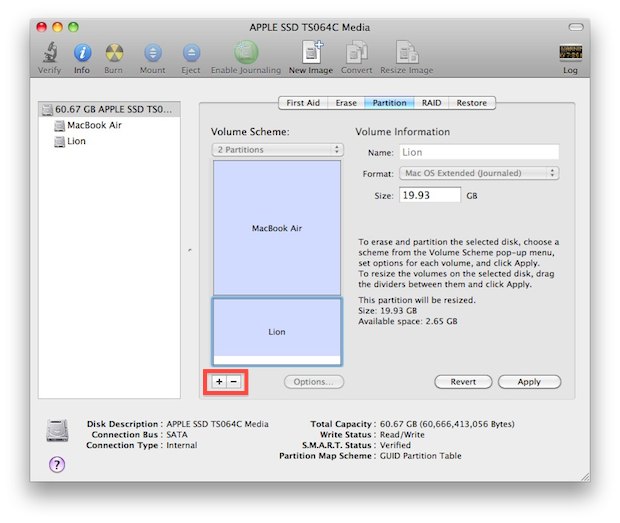If you want to create a new partition, modify a partition table, or remove an existing partition in Mac OS X, you won’t need to use anything fancy other than the built-in Disk Utility app. Be sure to have a full backup of your hard drive before adjusting partitions in any way just in case something goes wrong, the simplest way to do that is to start a quick manual backup through Time Machine. Once you have an adequate backup made, proceed with this walkthrough:
Add a New Hard Drive Partition in Mac OS X
- Launch Disk Utility from /Applications/Utilities/
- Select the hard disk you want to partition from the left side of the app
- Click on the “Partition” tab
- Click on the + button to add a new partition
- Specify a name for the new partition, select a filesystem type (Mac OS Extended Journaled is default), and choose a size either by manually entering a capacity or by dragging the slider bar in the partition map
- Click on “Apply” to create the new partition

You can make partitions any size as long as you have the available disk space to accommodate it, and creating the partition shouldn’t affect your existing filesystem either as long as there is free space. Nonetheless, there is always a chance something could go wrong, which is why I recommended you backup your drive first.
After you have clicked ‘Apply’ to create the new partition, it will be immediately accessible in the Finder to use how you want. A new partition will behave like a new hard drive, and it will appear on your Desktop as a new drive which can be ejected, mounted, formatted, just like a hard disk.
I partitioned my drive before installing Mac OS X Lion so that I could maintain my stable Mac OS X 10.6 system software while still exploring the Lion 10.7 Developer Preview. Another common use is to partition large external hard drives for a specific Time Machine backup partition, and then a separate storage partition. Time Machine will backup a drive until the available space is taken, so if you set it to backup to a partition, it will only take up that space and leave the other partition alone, allowing the drive to serve multiple uses and allowing you to effectively share a single hard drive for both Time Machine and other uses.
Deleting a Partition
Removing partitions is just as easy as creating one. All you need to do is follow the steps above to get to the partition table, select the partition you want to delete, and then click the “-” button rather than the plus icon. Remember, if you delete a partition, you will lose data that exists on it. Click “Apply” for changes to take effect on the drive.
Resizing Partitions
Resizing an existing partition to a new size, either by growing or shrinking existing partitions, can be done through Disk Utility very easily:
- From the “Partitions” tab, simply drag the separating bar between existing partitions either up or down to resize as needed
- Alternatively, click the partition to resize, then enter a new size value in GB in the Size box that is alongside the partition map
- Choose “Apply” to resize the partition
You do not need to reboot for any changes to take effect. As always, have a backup ready before making any changes to partitions, it’s rare that something will go wrong but in the event it does, you’ll be happy to have a backup handy so you can restore as quickly as possible.
0 comments:
Post a Comment